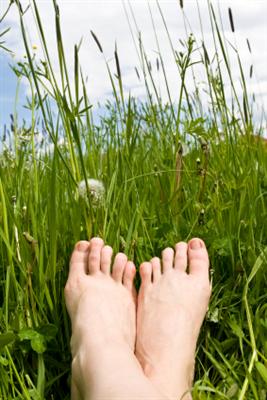Got Skin Problems?
It Could Be
Your Immune System
The skin, aside from being the main way that we recognize ourselves and others, is a major component of the immune system. It is the body’s first line of defense against organisms and an underestimated immune system powerhouse. Good care of the largest organ of your body is essential to good health, but the skin is actually designed to pretty much take care of itself.
Overcleansing, clogging your pores and using cosmetics with toxic chemicals may lead directly to disorders that include anything from acne and ezcema to cancer. We take it for granted that medications put into patches, such as nicotine and pain medication, are extremely effective. But we don’t think as much about how the thousands of environmental toxins in our cosmetics are absorbed constantly too - even while we sleep! And the effect of these chemicals may be contributing to the chronic illnesses we claim are from ‘genetics’ or ‘bad luck’.
Aside from the many immune system functions that we will discuss, Healthy Skin also:

• Regulates body temperature
• Prevents fluid loss
• Protects us from radiation
• Acts as a temporary storage area for fat, vitamins and electrolytes
• Absorbs chemicals and vitamins
• Directly communicates to the nervous system from the outside environment
All that and it looks good too!
There are many functions of the skin as it relates to being an Immune System Powerhouse! These functions are so important and so well-known that there is even a medical subspecialty of dermatology called Dermatological Immunology. The rest of this page will discuss the skin’s functions as they relate to the immune system
Stopping Invaders From Getting Into the Body
The barrier function should be fairly obvious. While it does a great job when it’s healthy, it can let in lots of organisms when it’s not so healthy. Scratches, burns, wounds, rashes and eczema can all allow pathogens to get through that barrier and activate the immune system. There are 3 layers, the epidermis on the outside, the dermis in the middle and the subcutaneous or hypodermis on the inside. Each of these layers also has its own layers, along with blood vessels, nerves and fat to give circulation, sensation and cushioning to prevent and to heal damage.
We are coated with naturally secreted oils. This function is so important that we have specialized glands – sebaceous glands – all over our bodies that do nothing but produce oils. This important function provides self-lubrication so that the epidermis stays intact. The entire outer layer is absolutely alive with organisms, many of them good bacteria that serve as a barrier for pathogens. At about 100,000 bacteria per square centimeter, there is no room for bad bacteria to settle. Pretty smart,huh! But this very effective barrier only works when it is intact. When it becomes damaged, it leaves you open to infections, rashes, eczema, discomfort and even severe water losses.
Some reasons that the barrier becomes damaged:
• Excessive washing, particularly with harsh soaps or antibacterial agents. This not only causes irritation, but actually breaks down the skin, damages the lipid layer, washes off the natural oils, disrupts the pH level and kills the ‘good’ bacteria.
• Excessive use of lotions and cosmetics
that block the
pores prevent the body from being able to
excrete toxins in sweat
• Obvious physical damage like scratches or
traumatic injuries
• Allergic reactions
• Excessive sun exposure
• Burns
Photosynthesis - Not Just for Plants

One of the most fascinating functions of Healthy Skin
is its ability to make substances when exposed to sunlight; in other words, photosynthesis. Vitamin D is the most commonly known of these substances. Humans must have Vitamin D to survive and the only ways that we can get it are sunlight and diet. Since few foods naturally have Vitamin D, egg yolks and fatty fish are the main sources, many governments have fortified common foods with it to prevent deficiencies. But the best way to ensure your Vitamin D needs are met is to expose yourself to small amounts of sunlight several times a week.
Of course there is an ongoing debate between dermatologists who believe that ANY amount of sunlight exposure puts you at risk for cancer, and researchers who say that a small amount of sunlight is actually beneficial and may PREVENT it.
"A little sunshine may be good for your immune system. This is what attracts T cells to the skin." -Hekla Sigmundsdottir of the Stanford University School of Medicine
Keeping in mind this debate, it is now being found that sunlight triggers immune system cells to come to the skin surface to repair any UV damage that occurs in response to sunlight!
Vitamin D is also a potent immune system catalyst as well. Potent antimicrobial compounds in the skin, called cathelicidins, require vitamin D for their production. Melanin is another product of photosynthesis. Melanin is well known as the pigment that give us the color we present to the world and is produced by specialized cells called melanocytes.
Melanin protects us from the harmful effects of UV by absorbing these rays and dissipating the energy as heat. Interestingly, both functions of photosynthesis are self-protectant mechanisms against sun damage. Again, if we don’t damage it too much, the skin pretty much takes care of itself.
Secretory Functions
Skin cells produce not only oils but they also secrete some more exotic immune system components to keep us fending off invaders.
The lowly sweat. It seems that this much maligned secretion contains the natural anti-infectives dermicidin and sphingosine. Until recently, we thought that sweat was only good for cooling off the body. But these substances have been found to be very important in the first line defense of the body.
Immunoglobulins, better known as antibodies, are proteins that are secreted in response to foreign invaders. These antibodies are located in the epidermis itself, creating a localized immune reaction to prevent the invaders from going any farther.
If the invader is not contained or if there is any tissue damage, the mast cells step in. There are about 7,000 cells in every square millimeter (about the size of a pin head) and are imperative for immune response. When needed they jump in quickly and secrete histamine, the chemical that we associate with the itchy runny nose of allergies.
But histamine does more than cause annoyance. It sets off a cascade of factors that causes blood vessels to dilate and become leaky leading to swelling and inflammation. This cascade causes other immune cells to activate and come to the rescue in order to kill the offending agents.
Detoxification
Along with the colon, kidneys and lungs; the skin is another organ of excretion. When the body gets overloaded with toxins, the pores provides another route to help detoxify the body by getting rid of these poisons.
The body can’t get rid of everything through sweating, but it can get rid of wastes like lactic acid, uric acid and ammonia.
There is much debate about the body’s ability to get rid of toxins like PCB’s and heavy metals through sweating. But studies have shown small amounts of metals like mercury, copper, cadmium, lead, nickel, aluminum and traces of drugs do come out in the sweat.
Sweating may not be the best way to detoxify, but it is one avenue to assist people with chronic illnesses to improve their health. Traditional cultures have used heat therapy like saunas and sweatlodges for centuries to improve health, and more and more studies are showing sauna therapy improves chronic illnesses like chronic fatigue syndrome and even congestive heart failure!
Even though it's tough, the skin is still a delicate organ that requires care to do its job. However, this beautiful covering is over scrubbed, over washed and coated with chemicals on a daily basis. If you begin to take care of your skin like the immune system organ that it is, your skin will very much help to take care of you.
Back to Top of Skin Page
Go To Easy Immune System Health Home





